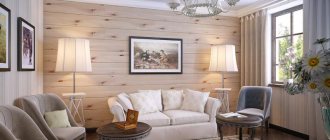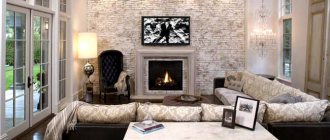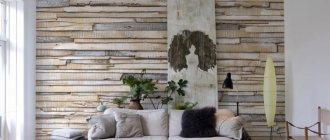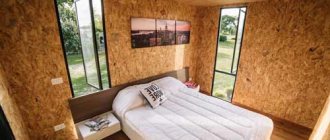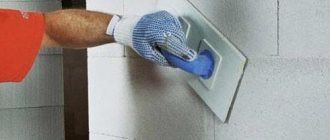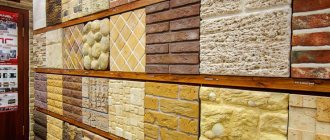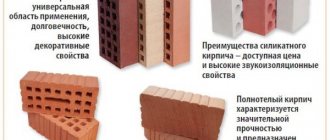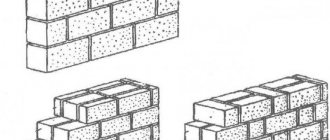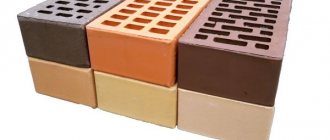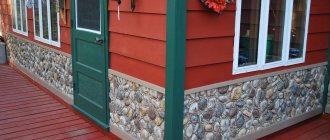Artificial gypsum decorative brick is an inexpensive material for facing work and interior decoration.
If you are choosing the ideal material for the original decoration of the interior and exterior of the building, then you have come to the right place. The company presents to your attention decorative gypsum bricks in a decent assortment and at a competitive price. This material has been known since the times of Ancient Greece, and today the demand for it is steadily growing. Decorative brick, the price of which in our company is lower than the market average in Moscow and the Moscow region, will help bring the most daring design ideas to life.
On our website you can buy artificial gypsum decorative bricks wholesale (large and small) and retail. To place an order, call us on +7 and +7 from 7.00 to 00.00 Moscow time.
Decorative gypsum brick has a harmonious combination of performance characteristics and affordable cost. Since gypsum is a fairly soft material, it can be easily processed, which allows you to give it any texture. If you add to this a large number of shades, it becomes obvious that the material opens up wide scope for your design creativity. There are many variations on the theme of using artificial brick, which can act as the main element in the interior, as in the “loft” style, or as a partial decor option, as exemplified by the “country” and “English” styles.
You can buy decorative bricks in Moscow at. A large selection of products, including glossy and matte, embossed and torn bricks.
Properties and scope of application of decorative bricks
Decorative brick tiles have a thickness of 0.8-2 cm; in appearance, they resemble the side or end surface of standard building bricks, which are used to build walls. Decorative tiles are made from environmentally friendly natural materials.
The popularity of this material is due to the successful combination of performance properties:
- it has high mechanical strength;
- resistant to temperature changes, humidity and chemical attack;
- service life more than 50 years;
- decorative brick does not load load-bearing walls;
- it is environmentally friendly;
- allows vapors and gases to pass through, allowing the building to “breathe” and get rid of dampness;
- provides additional sound insulation;
- Decorative brick has a regular shape. This makes it possible to obtain different patterns and types of masonry;
- he is easy to work with.
The listed qualities make it possible to use decorative bricks when decorating any premises of residential and public buildings.
Ceramic brick
The very first material for such tiles was ceramics. In fact, it is no different from the bathroom tiles that everyone is familiar with. Now it is also available in different types of relief.
Features of use
The range of manufactured decorative bricks makes it possible to choose many options for any design. The material is universal, but there are specific features when choosing a collection and how to decorate different rooms. In the living room, it is advisable to choose a color so that it matches or, conversely, contrasts with the furniture installed there.
Dark tones give a feeling of warmth, but in excess they create a depressing impression. A good solution could be alternating areas of brickwork and completely smooth areas. Decorative bricks can be used to lay out the space around the fireplace, make a suitable background for a wall-mounted TV, or frame arches, door and window openings. In the hallway there is a high probability of mechanical impact on the walls, so it is advisable to protect them with a continuous layer of decorative tiles.
For small rooms, it is better to use light colors. The frame of doors and mirrors can be done in a different color, which will help guests quickly get used to their new space and give the interior additional charm.
In the kitchen, you can decorate the entire space or just the work area with decorative bricks. Usually, preference is given to products with minimal porosity, which are coated with water-repellent compounds. Thanks to this treatment, it is possible to carry out wet cleaning of the masonry. Typically, when decorating a kitchen space, you stick to warm tones, but neutral tones can be refreshed with bright or white interior elements.
In the bedroom, decorative brick looks good at the head of the bed - not only because of aesthetics, but also because of its sound insulation properties. Pastel colors or white are more suitable here; against the background of such a wall you can hang pictures or add textile inserts. If you want a rich color palette, you can use reddish-brown tiles to match classic-style wooden furniture.
In a children's room it is better to use decorative tiles with the smoothest possible outer surface. With its help, you can decorate the room in the form of a fairy-tale castle or a dungeon with treasures. Try alternating flat and raised areas, framing openings and arches, and adding photo wallpaper. For younger children, bright colors are often chosen. Teenagers often like a minimalist loft in white or taupe.
Design moves
In the design environment of the West, the fashion for the ascetic, gloomy appearance of rooms appeared quite a long time ago. We did not immediately accept it. Not every average person is ready to give their home such a harsh look. Brick-like tiles for interior decoration can create a lighter imitation of masonry, especially if they are used not to decorate the entire room, but only part of it. You can asymmetrically cover one of the walls or part of it.
The design of corners with artificial brick looks very stylish.
The decorative finishing of a corner, the design of a space near a mirror, or the spectacular lining of a wall niche with imitation brickwork in combination with other design elements looks beautiful. Finishing all walls in the form of brickwork is acceptable when decorating a kitchen in the English style. But for this, the kitchen must be spacious and well-lit, and the decoration must include wood and ceramics. The wall above the working surface can only be made of clinker bricks, since gypsum decorative finishing is unacceptable here.
In the corridor, it is recommended to use light brick or white grout against a dark stone background.
Combined finishing with artificial stone tiles would be an excellent choice for a room with a fireplace.
If it is made of unsuitable material, then it should be faced with ceramic tiles. In order to get rid of excessive gloom, you should prefer lighter shades than natural brick. The relief surface of the artificial stone gives the home the appearance of a medieval fortress.
Imitation of masonry must correspond to the general design concept
For a loft, deliberately rough walls in muted tones with many uncovered beams, pipes and other communications are suitable.
The classic style is best suited to the dark brown or red-orange color of aged brick with contrasting light grout.
For country or Provence, choose pastel shades that echo wooden furniture and other decorative elements.
High-tech is more often associated with the most accurate single-color masonry.
Before purchasing decorative bricks, we advise you to check:
- compliance of the tiles with the chosen style and interior design;
- a combination of texture and color scheme with furniture and other finishing elements.
- compliance of the technical characteristics of the material with operating conditions;
Laying features
The aesthetic perception of an interior decorated with decorative bricks depends not only on the texture and color of individual bricks, but also on the chosen type of masonry - the characteristic order of alternating spoon and butt elements in each row with a gradual displacement of vertical seams or with symmetrical repeatability from layer to layer . The most commonly used masonry options are:
- Gothic;
- English two-row;
- Dutch;
- cross;
- Brandenburg;
- Silesian;
- spoon with an offset of ½ or ¼ brick.
The color of different batches of the same collection and article may vary due to the use of natural materials in the production of decorative tiles.
To avoid the formation of prominent color spots on the wall, an experienced craftsman takes tiles from different boxes and, before gluing them to the wall, lays out a small fragment of the future masonry on the floor, selecting tiles of different colors and textures so as to obtain the desired visual effect.
Hard tiles
Available in various compositions, it can be clay, gypsum, cement, dye and plasticizers. There are no problems during installation, just like with flexible tiles. Next, we will consider options for the execution of such material. Excellent solutions for creating decor and decorations with your own hands can always be found on the website: https://podelki.guru.
Installation technology
Decorative bricks are always laid on a previously leveled surface free of dirt. Finishing work begins only after the completion of shrinkage of the new building. During installation, aqueous solutions are used, so the room must have a positive temperature. It is advisable that there are no areas on the wall that are strongly heated by direct sunlight or turned on heating devices.
The best base for laying tiles is plastered brick, foam block or concrete. When pre-leveling walls with plasterboard, it is better to use waterproof grades followed by applying a thin layer of plaster. It is allowed to install decorative bricks on wood, metal or plastic. Such surfaces are covered with waterproofing material, onto which a reinforcing mesh is attached and a layer of plaster is applied.
Immediately before finishing, it is recommended to saturate the leveled surface with a deep penetration primer. After it has dried, you can begin the main work. The procedure is as follows:
- On the floor you need to lay out a certain amount of stone from different boxes and, selecting tiles by color and texture, assemble a small fragment of the future masonry.
- In accordance with the manufacturer's instructions, mix a portion of the adhesive solution and apply it with vertical movements with a notched trowel onto the section of the wall that the master will have time to cover before the mixture dries.
- The back surface of each tile is covered with a thin layer of glue, after which it is installed with slight pressure on the designated area. To achieve high quality masonry, it is recommended to use a laser level and seam clamps. The adjustment can be made within 5-10 minutes.
- The wall with the tiles applied to it should stand for 2-3 days, so the solution will gain sufficient strength.
- The space inside the seams and the outer surfaces of the brick are cleaned of excess glue.
- The grout pre-selected by color for wide joints is mixed with water until a solution of the desired consistency is obtained. The joints between the tiles are filled using a caulking gun or a conical grout bag, leaving no voids. The depth of the grout layer in the joint must be at least 6 mm (about half the thickness of the brick tiles).
- You need to wait 30-40 minutes and unstitch the seams. Using a mason's jointing tool, compact the mixture, cut off excess and form the outer surface.
The use of decorative bricks in interior decoration provides ample opportunities for the implementation of any design solutions. The material has a noble appearance, is affordable and quite easy to install. High strength and resistance to various types of external influences guarantee its durability and allows you to do without repeated repairs for a long time.
Porcelain stoneware brick
Recently, porcelain tiles have gained popularity. It will not be possible to make it yourself due to the very high firing temperature and the unavailability of materials.
Such tiles are frost-resistant, do not absorb moisture, do not require maintenance, and are suitable for any place, including the street. The shelf life reaches 40 years, and this is only according to the manufacturers.
